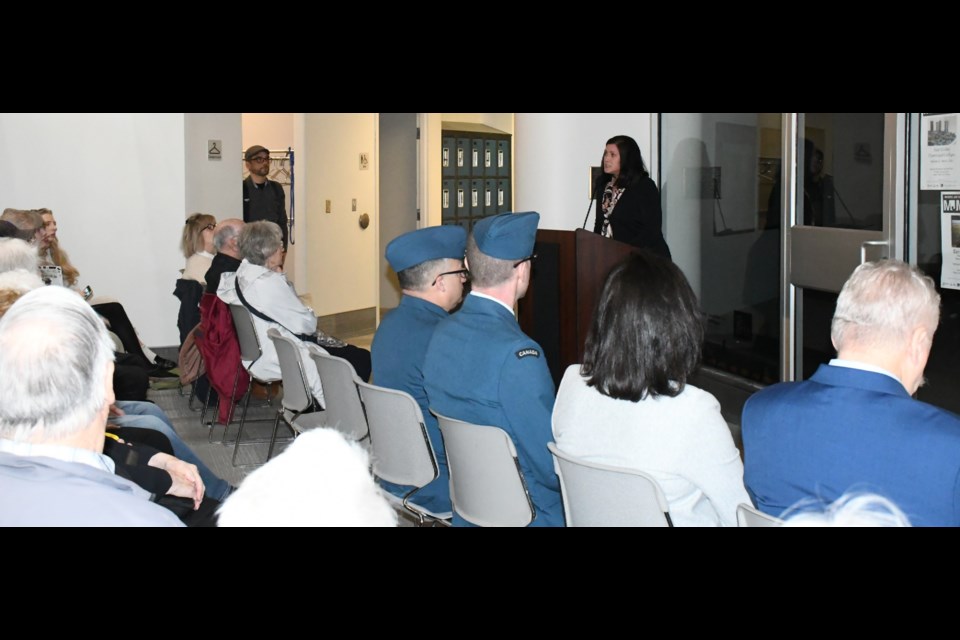Silence filled the Moose Jaw Museum and Art Gallery as residents paid homage to nearly 40 people who died in a mid-air collision in 1954 on “an incredible day of tragedy.”
Nearly 50 residents filled the venue’s foyer on April 8 to remember the 37 people who lost their lives 70 years ago when a Royal Canadian Air Force (RCAF) Harvard trainer and a Trans-Canada Airlines (TCA) North Star collided at 10:02 a.m.
Among the dead were 35 people on the passenger plane, 15 Wing pilot Thomas Andrew Thorrat, and Martha Hadwen, the only resident to die after the passenger plane’s fuselage fell onto the Gordon Hume house where she was cleaning.
The two planes were both flying at 4,000 feet when they collided, creating a debris field in the community’s northeast that was nearly five kilometres (three miles) in diameter, explained Jennifer McRorie, MJMAG curator and event MC.
The TCA plane’s engine landed on Main Street’s north end, while its fuselage missed Ross School and its 360 students by 500 feet but hit the Hume house at 1324 Third Avenue Northeast.
This was the worst incident in TCA history to that point.
Thorrat, 22, was Scottish and left the airbase at 9:57 a.m. on a solo flight from Moose Jaw to Raymore and back. Meanwhile, the passenger plane was on its way from Winnipeg to Vancouver, with its last radio transmission at 9:50 a.m. Mountain Standard Time.
After the crash, a large group of civilians, provincial officials and military personnel put out fires, collected bodies, contacted families of the deceased and located evidence, said McRorie.
“Seventy years later, we remember this tragic event, the lives that were lost and the impact it’s had in our community, not only on April 8, 1954, but the lasting impact it’s had today … ,” she added.
Paula Shareski, the granddaughter of Martha Hadwen, took to the podium and thanked people for attending. She noted that four generations of the Hadwen family were present, including her father, her children and her grandchildren.
She concluded by describing April 8 as “an incredible day of tragedy.”
Community poet Robert (Bob) Currie recited a poem he wrote for the event. Before doing so, he recalled some friends from high school who went to the crash scene, with one boy returning traumatized, pale and quiet.
“And when people asked him what he’d seen, all he said was, ‘We didn’t know, we didn’t know,’” Currie said.
After Currie spoke his poem, the crowd stood for two minutes of silence, with the silence ending at almost 10:02 a.m.
A day in high school
Russell Wheatley, 87, was in Grade 11 at Central Collegiate when the incident occurred. His agricultural class had just started when the collision occurred, rattling the windows.
“We looked out and saw the plane and smoke going down. And then the teacher said, ‘We’ll get back to business here,’” Wheatley said.
Some students travelled to the site at lunch and, while they couldn’t go near it, did return with artifacts they had picked up on Main Street.
“It’s a lot of memories. It’s always been there (in the brain),” said Wheatley, pointing out that Thorrat could have landed on the exhibition grounds’ racetrack — then between Ross School and the armouries and behind the Hume home —if he had another 20 feet of elevation.
“It’s one of those things. Sometimes you get lucky and sometimes you don’t, and that was one of those times,” he added.
15 Wing remembers
Maj. Chris Jacobson, from 15 Wing, said the event was important because the collision was a “terrible tragedy” that claimed a fellow airman and affected Moose Jaw. He noted that many current personnel are heavily involved in community activities, so it was appropriate to attend to honour the dead.
The airbase has a small display with artifacts and newspaper clippings that pay homage to the collision, which Jacobson relied on for research. Meanwhile, base personnel have discussed this incident regularly during his 11 years there and asked questions about why and how it occurred.
Many operational rules for airlines have changed in 70 years, including planes forbidden from flying low and improvements made to radar, he continued. Moreover, since the inception of the NATO Flying Training in Canada program at 15 Wing decades ago, there have been no training collisions — aside from the Snowbirds having some mechanical troubles.
“So we’ve made changes that work and preserve life and we’re proud of that,” Jacobson added. “None of that takes away from the tragedy, however, of this event.”




